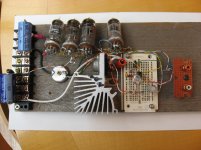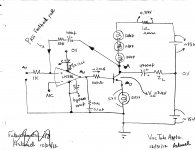Several DIY solid state amps use light bulbs as incandescent load resistors. For example, the De-Lite Amplifier by Mr. Pass, the SIT amp by Mr. Rothacher, and wrenchone's L'Fake amp. Mr Pass hailed their resultant sound as Organic and different in character than using common load resistors and current source loads. So, why not use the heaters of vacuum tubes in a similar application. Apparently, this idea is not new. Please see the thread in the Pass Labs Form by the DIYer wrenchone which has a title beginning with L'Fake...Its last page shows such applications. I'll reproduce mine in this thread.
A valve heater might work better* than a bulb, as it is likely to have greater thermal mass so will introduce less bass or signal envelope distortion. Of course, those people who prefer distortion will prefer to use a bulb.
* in this context, 'better' really means 'less badly'
* in this context, 'better' really means 'less badly'
curious resistors
Hi there: Intend to use my toster, ele'c coffee pot, and toster oven for circuit reistors, and if needed for parallel output devices a pair of waffel irons. To use an old jazz term...should that "should cook". ....regards, Michael
A valve heater might work better* than a bulb, as it is likely to have greater thermal mass so will introduce less bass or signal envelope distortion. Of course, those people who prefer distortion will prefer to use a bulb. * in this context, 'better' really means 'less badly'
Hi there: Intend to use my toster, ele'c coffee pot, and toster oven for circuit reistors, and if needed for parallel output devices a pair of waffel irons. To use an old jazz term...should that "should cook". ....regards, Michael
Look at Pete Millett's Starving Student Headphone amp. It uses the tube heaters as the load for a mosfet follower. The amp was succesful enough to deplete the worlds supply of 19J6 tubes.
Starving Student hybrid
Starving Student hybrid
A picture of the prototype amp is attached. I'll show its attendant schematic in a following post. I built it on a 1" by 6" wood board. Its power supply is a regulated dual +/-15 VDC, and enters at the terminal strip on the left of the picture. Ouput power to a loudspeaker [full range 8 Ohms or 16 Ohms] exits at the terminal strip via the the DC blocking cap [4,700 uF]. The circuit of LM386 was assembled on an experimenters proto board. The vacuum tubes [12AX7] were mounted on terminal strips by soldering on them one of their mounting holes.Thank you all for your valuable input. I'll post today a picture of the prototype. I wish you a happy, healthy, and prosperous 2013.
I was pleased with the sound quality. Clear, detailed, no hum and tonally balanced. I'll have more on its subjective and objective measurements in upcoming posts.
Best regards
Attachments
Thanks Enzo for your info. Please show schematic(s) when you stumble upon them. Incandescent load apps. Surprisingly [or not] the modulated heater current [while driving a loudspeaker] reaches the cathode, grid and plate as a varying voltage.Can't remember just where, but some guitar amps have been made with preamp tube heaters as cathode resistor for the power tube.
By other uses, I assume you do not mean things like computer logic, thryistor tubes controlling solenoids, and so on.
Surprisingly [or not] the modulated heater current [while driving a loudspeaker] reaches the cathode, grid and plate as a varying voltage.
Antoinel,
Not surprising--but I have wondered what the effects are with plate and screen voltages in place with their bypasses, and sufficient bias applied to grid via cathode resistor or LED are. I will post the scheme of my amp soon, just having trouble finding the time anymore! I am making an assumption of course, that you observed voltages on the tubes pins without any of the above mentioned voltages in place---or perhaps you had applied voltages?
This is interesting to me as it will be instructive to learn the nature of what any feedback is, whether it be degenerative or regenerative, or possibly some wacky combination of both. All I know is, the amp sounds better than I thought it should. What amp? Well, I will try to post the schematic tomorrow.
What type of speaker are you using and how loud will it go? Is it driven well enough, or do you feel some pre-amplification is in order?
Thanks and Happy New Year!
Terry
I once used a 7 pin signal tube and a 6v lantern battery to keep my hands warm as a teenager.
The idea was that I would put the battery on my belt and keep the tube in my top pocket for warmth.
Never did do that, I just kept connecting the leads to the battery and holding the tube in my hands to keep warm.
The idea was that I would put the battery on my belt and keep the tube in my top pocket for warmth.
Never did do that, I just kept connecting the leads to the battery and holding the tube in my hands to keep warm.
Last edited:
and the tubes produced sound by itself, without a loudspeaker!
The sound heard coming from your amp is most likely produced by the OPT. I have some OPT's that are rather loud and some totally quiet. Loud ones can sometimes be quieted by jamming something between the bobbin and the core. Sometimes the windings themselves produce sound.
It is common for tubes to produce random sounds associated with thermal expansion. Sometimes these sounds wind up in the speakers at a low volume.
I have never heard music come from a tube, but if one had something inside that was free enough to vibrate, it would be a better microphone than speaker. I have a Motorola branded 6SN7 that is microphonic enough that you can talk to it and hear yourself in the speaker. Turn the volume loude enough and acoustic feedback occurs.
I have never heard music come from a tube, but if one had something inside that was free enough to vibrate, it would be a better microphone than speaker. I have a Motorola branded 6SN7 that is microphonic enough that you can talk to it and hear yourself in the speaker. Turn the volume loude enough and acoustic feedback occurs.
I have a EL34 PP amp that plays music with no input signal. Some local radio station....I gotta get inside the thing and fix it.
Thank you all for your valuable input. You did have "Other Apps" for vacuum tubes. A hand warmer will be useful for a snow-stranded motorist. Cosmetic apps; like those of Post #1. A vacuum tube as a small loudspeaker; I wonder about its frequency range and relative loudness. An app which keeps showing up is using independent tube heaters as cathode resistors in vacuum tube preamps and power amps.
A happy and safe 2013 to you all.
A happy and safe 2013 to you all.
Thanks for your input. You described an omnidirectional microphone.The sound heard coming from your amp is most likely produced by the OPT. I have some OPT's that are rather loud and some totally quiet. Loud ones can sometimes be quieted by jamming something between the bobbin and the core. Sometimes the windings themselves produce sound.
It is common for tubes to produce random sounds associated with thermal expansion. Sometimes these sounds wind up in the speakers at a low volume.
I have never heard music come from a tube, but if one had something inside that was free enough to vibrate, it would be a better microphone than speaker. I have a Motorola branded 6SN7 that is microphonic enough that you can talk to it and hear yourself in the speaker. Turn the volume loude enough and acoustic feedback occurs.
Interesting. The LM386 chip in my app has done that too.I have a EL34 PP amp that plays music with no input signal. Some local radio station....I gotta get inside the thing and fix it.
- Status
- This old topic is closed. If you want to reopen this topic, contact a moderator using the "Report Post" button.
- Home
- General Interest
- Everything Else
- Other Applications of Vacuum Tubes

